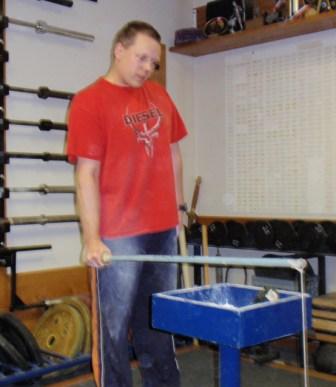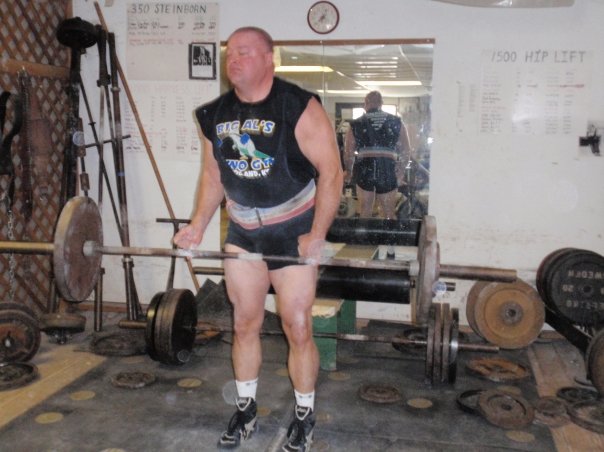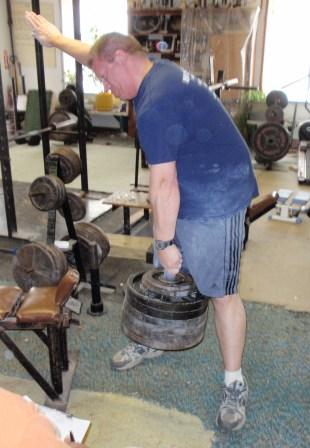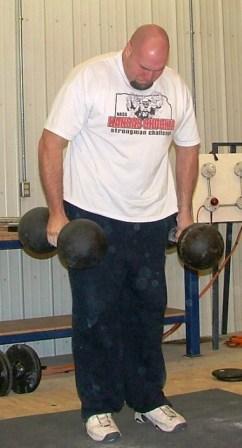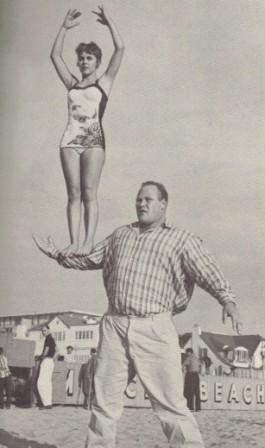The Weaver Stick
by Al Myers
I saved the most interesting lift for this last story covering the lifts that are in this weekend’s upcoming Dino Gym Grip Challenge. The Weaver Stick is one of the most perplexing and misunderstood lifts in the USAWA lineup of lifts. Bill Clark once told me that “judging the Weaver Stick is more subjective than judging depth in a squat.” I definitely agree! I will be the Official Judge in this competition, and I will make sure that everything is done right and all competitors will be judged equally and fair. The most subjective part of judging the Weaver Stick is making sure that the lifting arm remains straight at the side with elbow locked. With just a little bend at the elbow, other muscles can be pulled in to play, and much more weight can be lifted. The Weaver Stick is a leverage lift that tests the ligament and tendon strength of the wrist, primarily above the thumb. It is surprising how little weight can be supported this way. John Grimek many years ago set the World Record in the Weaver Stick at 11 3/4 pounds.
The Weaver Stick is named after George Weaver of Brooklyn, who popularized it in the early 1940’s. However he didn’t really invent it. Many years before this Paul Von Boeckmann of New York City found that he had a “special knack” for this type of lifting and had a early version of the Weaver Stick made out of a broom handle. He won several bets with his ability to lift it with weight attached by a rope on the end of it. George Weaver based the measurements of the Weaver Stick from Von Boeckmann’s broom handle, and the regulation Weaver Stick length of 36 inches was born. By the way, Paul Von Boeckmann was VERY GOOD with the Weaver Stick and is credited with a forward lift of 11 1/2 pounds. When he was over 60 years of age he could still do 9 1/2 pounds!! The Weaver Stick has also been contested backwards – meaning you face away from the Weaver Stick. Slightly more weight can be lifted this way. However, at this meet you must perform the Weaver Stick in the forward manner. I would say a great lift is anything over 6 pounds, with most lifters capable of between 4 and 6 pounds if done correctly. Occasionally in the gym we have pulled out the Weaver Stick to “play around” at the end of workouts. I am always surprised by what guys lift. You can never predict. I don’t think there is any correlation between overall body strength and ability with the Weaver Stick. It is a humbling feeling to fail with 5 pounds when you can deadlift over 500 pounds. The great Warren Lincoln Travis is said to have been only able to do 4 1/4 pounds with the Weaver Stick. The top lift ever done with the Weaver Stick in the USAWA is 7 pounds. This was accomplished by two lifters – Tom Ryan and Mark Mitchell.
“A Weaver Stick is used for this lift. The Weaver Stick utilizes a wooden broomstick with these dimensions. The handle is 5 ½ inches in length. The junction of the handle and the rest of the Weaver Stick may be marked with tape, or with any material that is raised to provide a distinct separation between the handle and the rest of the stick. This marking is ½ inch in length. At a point exactly 36 inches from the end of the marking, or 42 inches from the end of the handle, a notch is made in the stick to allow a cord to be attached to it. This cord may be of any length. Weight is tied onto the end of the cord. The Weaver Stick must rest on a flat lifting surface with the weight hanging free. The lift will begin at the lifter’s discretion. The lifter will take a position alongside the Weaver Stick, and grip the handle of the Weaver Stick by one hand, facing the length of the stick. The lifting hand and arm must remain straight with elbow fully locked, and must not be in contact with the body during the lift. The lifting arm must remain at the lifter’s side throughout the lift. The heel of the hand must remain on top of the Weaver Stick. If the hand twists under the stick during the lift, it is a disqualification. The non-lifting hand must not touch the lifting arm, lifting hand, or Weaver Stick during the lift. The lifter’s body must be upright with legs straight at the completion of the lift, but the legs may bend when picking up the stick. The Weaver Stick must be lifted entirely clear from the lifting surface while maintaining the stick parallel to the floor. If the end of the stick containing the weight dips to any degree, it is a disqualification. If the lifting hand moves to a position in front of the handle marking during the lift, it is a disqualification. Once the Weaver Stick is motionless, an official will give a command to end the lift. Records are also kept for the Weaver Stick with the lifter facing backwards, away from the length of the stick.”
